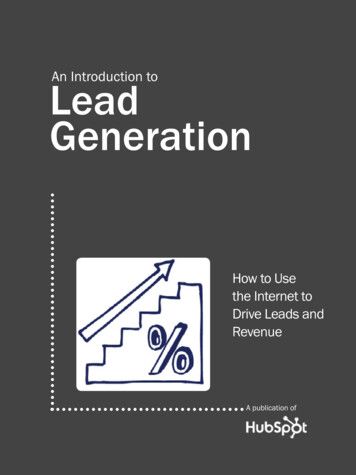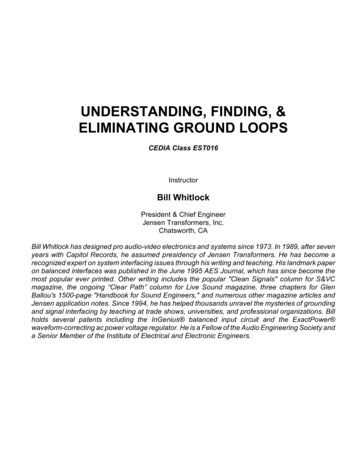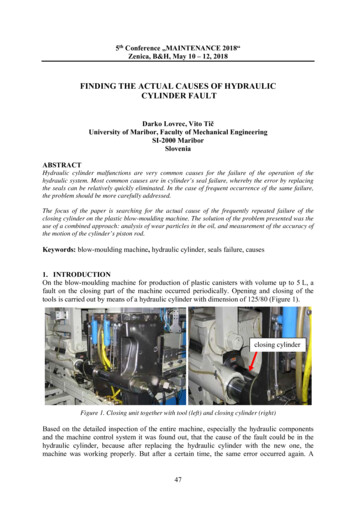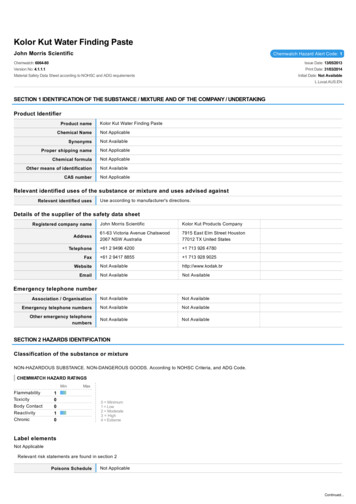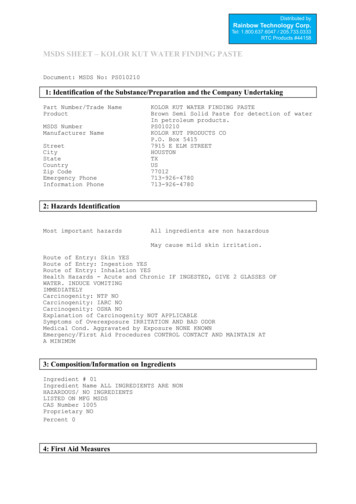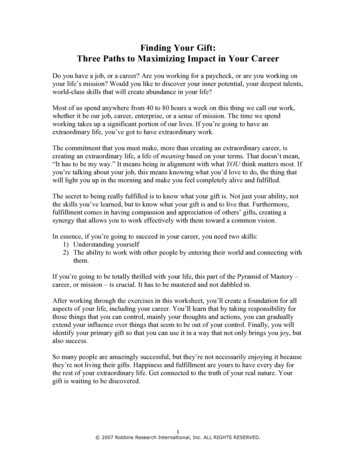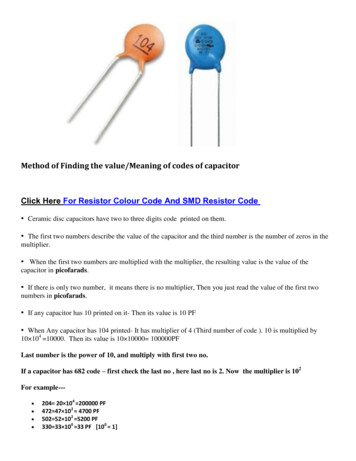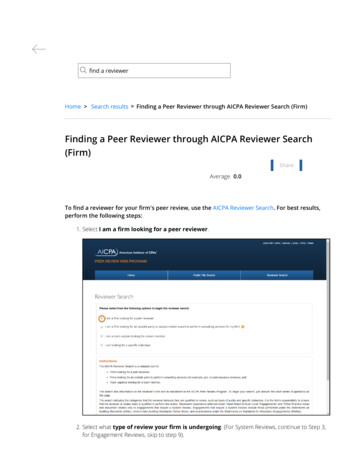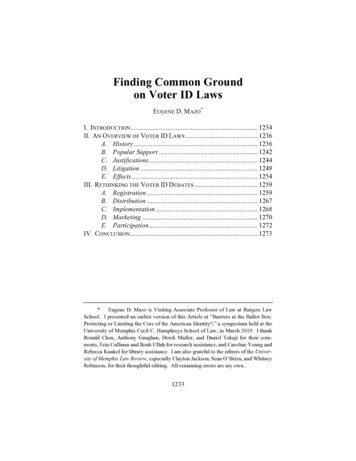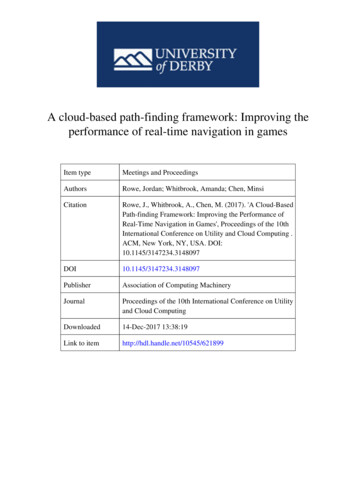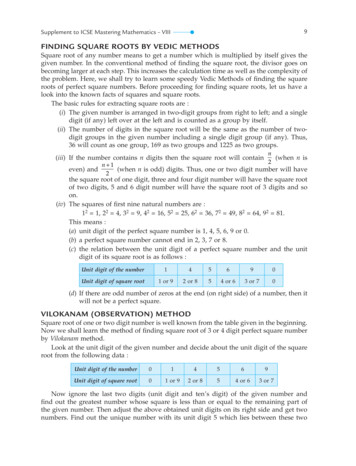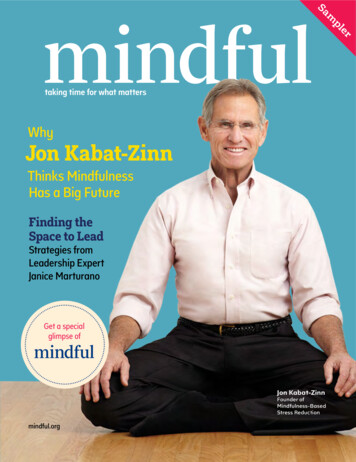
Transcription
SaplmerWhyJon Kabat-ZinnThinks MindfulnessHas a Big FutureFinding theSpace to LeadStrategies fromLeadership ExpertJanice MarturanoGet a specialglimpse ofJon Kabat-ZinnFounder ofMindfulness-BasedStress Reductionmindful.org
from the foundersBeing MindfulNow is the TimeSomething important is happeningin our society today: people are beingmindful. More often. In more ways. Andin more places. In our view, the simpleact of being present has the power tochange everything—how we approachourselves, our challenges, our relationships, and our communities. We believebeing mindful is an idea—actually, a wayof being—whose time has come. Weare launching Mindful to celebrate andsupport this growing movement.Mindfulness is not obscure or exotic.It’s familiar to us because it’s what wealready do, how we already are. It takesmany shapes and goes by many names.In his basketball days, former senator BillBradley called it a sense of where you are,and for many athletes today it’s being in thezone. For caregivers, it’s attention and empathy. For soldiers and first responders, it’ssituational awareness. For business leaders,it might be presence or flow. Artists see it asspontaneity and thinkers as contemplation.Mindfulness is not a special addedthing we do. We already have the capacityto be present, and it doesn’t require us tochange who we are. But we can cultivatethese innate qualities with simple practicesthat are scientifically demonstrated to benefit ourselves, our loved ones, our friendsand neighbors, the people we work with,and the institutions and organizations wetake part in.When an idea’s time has come, it’spart of the zeitgeist, the spirit of the times.From the April 2013 issue of Mindful mindful.orgLiving mindfully is one such idea. Solutions that ask us to change who we are orbecome something we’re not have failedus over and over again. We’re ready for anapproach that recognizes and cultivates thebest of who we are as human beings.Mindfulness is not only timely. It alsohas the potential to become a transformative social phenomenon, for these keyreasons: Anyone can do it. Mindfulnesspractice cultivates universal humanqualities and does not require anyoneto change their beliefs. Everyone canbenefit and it’s easy to learn. It’s a way of living. Mindfulness ismore than just a practice. It bringsawareness and caring into everythingwe do—and it cuts down needlessstress. Even a little makes our livesbetter. It’s evidence-based. We don’t have totake mindfulness on faith. Both science and experience demonstrate itspositive benefits for our health, happiness, work, and relationships. It sparks innovation. As we deal withour world’s increasing complexity anduncertainty, mindfulness can lead us toeffective, resilient, low-cost responsesto seemingly intransigent problems.This mindfulness movement is alreadyemerging in many places and making a realdifference. In hospitals and doctors’ offices,it’s improving patients’ health and delivering better care. In classrooms, teachers areusing it to foster healthier learning environments. First responders are becoming moreresilient, and trauma sufferers are usingit to heal. In business, mindfulness andawareness—and yes, kindness and compassion—are increasing job performance andsatisfaction. In every sphere, leaders findthat mindfulness practice helps keep theirvision alive in the heat of the moment.Our mission at Mindful is to support thismovement and all who want to live mindfully. We’ll do so through Mindful magazineand its digital edition; with our website andapplications that deliver mindful content tomobile devices; and in conferences, collaborations, and conversations where inspiringideas can become the building blocks of amindful society.Mindful will tell the stories and celebrate the heroic efforts of people improving our world by being mindful. We’ll shareadvice, how-to instruction, news, andinformation. We’ll connect mindful people,communities, and organizations with eachother. We’ll help the mindfulness movement deepen and broaden and introducethis way of living to wide new audiences.Like all who are committed to a mindfullife, we want the mindfulness movement tohave a beneficial impact on our society.Welcome to Mindful. Please come asyou are. As we do our best to bring youhelpful information and stories and createconnections, we look forward to hearingfrom you. We want to know your concernsand insights and learn what you’re doing.Let’s be mindful together. Healthy Mind,Healthy Life.When you subscribe toMindful, you will: D iscover practical, effective toolsfor everyday living L earn about the latest brain scienceand the many ways mindfulness ischanging our society E njoy better health and relieffrom stress I mprove your performance andcapacity at work Deepen the relationships in your life B e inspired by stories of othermindful people like youClick hereSubscribeNowDon’t miss the next greatissue of Mindful.
healthno blueprint,just loveIn 1979, Jon Kabat-Zinn recruited chronicallyill patients not responding well to traditionaltreatments to participate in his newly formed eightweek stress-reduction program. Now, 35 yearslater, Mindfulness-Based Stress Reduction (MBSR)and its offshoots have entered the mainstream ofhealth care, scientific study, and public policy.We talk to the health and well-being pioneer aboutwhy mindfulness has attracted so much attentionand why it will continue to do so.Photographs by Joshua Simpsonmindful.org From the February 2014 issue of Mindful
healthhealth“If there’s an instruction manual forbeing human, then Western science andmedicine have supplied one part of it,and the contemplative traditions havesupplied another—the part that has todo with discovering and cultivating ourdeep interior resources.”From the February 2014 issue of Mindful mindful.orgMindful: Did you ever think the work that started in amodest clinic in a spare room of a hospital in CentralMassachusetts would become so influential?Jon Kabat-Zinn: In a word, yes. I never thought ofthis work as a small thing. I don’t think of myself asa big deal, but I always thought of this work as a verybig deal. It wasn’t just about thinking that meditation had a modest contribution to make to Westernmedicine. MBSR was built on the conviction that theinsights, wisdom, and compassion of the meditativetraditions were equal in import and magnitude tothe great discoveries about human life we’ve madein the West. If there’s an instruction manual forbeing human, then Western science and medicinehave supplied one part of it, and the contemplativetraditions have supplied another, the part that hasto do with discovering and cultivating our deepinterior resources.My hope was that by starting a stress-reductionclinic based on relatively intensive training in mindfulness meditation and yoga—and their applicationsin everyday living—we could document how thesepractices might have a profound effect on the healthand well-being of individuals. The larger purposewas to effect a kind of public-health interventionthat would ultimately move the bell curve of theentire society.And it grew to the point where we now talk aboutmindfulness-based interventions in all sorts of areas—depression, childbirth, education, addiction, to namejust a few.We didn’t have a specific blueprint, but I am verygratified that so many developments have beenhappening on so many different fronts. It’s reallya matter of planting seeds. You never really knowwhat will sprout from these seeds and how theywill spread. That’s the beauty of it. It’s based onnot-knowing—approaching the world inquisitively,with a fresh mind.If we had come in with a plan, with an ideology,with all the answers, I think it would have remainedsmall. Instead, those of us involved in this workhave paid close attention to just a few essentialelements. One is that mindfulness is not a specialstate you achieve through a trick or a technique. Itis a way of being. I have a lot of faith that if peoplejust learn how to be in the present through simplemindfulness meditation, then the practice does thework of transformation and healing. We do not needto do it for them. People are so creative and intrinsically intelligent that given a chance, they perceivethe truth within their own experience. “When I getattached to something, I suffer,” they realize, “andwhen I don’t get attached, I don’t.”What else makes MBSR work?The eight weeks of the MBSR curriculum offer areliable protocol that is used in many studies of theeffects of mindfulness meditation practice. Peoplewho have taught it a lot have seen that it has anintegrity of its own. If they try to switch thingsaround—a little more of this, a little less of that, takethis out, put this in—they find it isn’t as effective.Yet it’s only a framework. It’s only as effectiveas what the teacher brings to it and how he or she“holds the space,” as we say. It simply will not workif it is scripted or formulaic. If the teacher doesn’tfeel competent in one of the elements, say yoga, itdoesn’t work if they bring in an outside expert. Theyhave to get the training and embody it themselves.Everything that is taught has to be lived. Life is thecurriculum.As a teacher, you are trying to convey somethingthat can’t be conveyed in words. Mindfulness is alsoheartfulness—you need poetry as much as prose.What truly makes mindfulness training work is love.If the teacher holding the class is profoundly in lovewith what they are doing and with the people in theclass in a fundamental way, it will work. If they arenot, it will peter out.“Mindfulness is not a special state youachieve through a trick or a technique.It is a way of being.”20,000The benefits of mindfulness go far beyond stress reduction. Why did you call your program that, and are youstill satisfied with your choice?meditatorsI wanted it to speak to universal experience. Everybody can relate to stress. It’s a common Englishword and a common experience. The science onstress is proving that it was a good choice. We findout more every day about the negative effects ofstress on the body, on the immune system, on aging,and so on. Likewise, there is a correspondinglystrong interest in how we can develop resiliency inthe face of stress, which is a benefit of mindfulnesspractice.More than 20,000 people have completed theMBSR program at the UMass Stress ReductionClinic and countless more in other locations.ILLUSTRATIONs BY megumi yoshida (top); stuart mccoy, from the noun project (bottom)In early 2005, I met Jon Kabat-Zinn athis home in Massachusetts. I came asa meditation practitioner and journalistwith a bit of skepticism about MBSR.I was curious whether the attempt tobring secular mindfulness to the broadersociety could be effective. In a lengthy,impassioned conversation, I began to bepersuaded of its validity and power, andas a result we started down on a path offurther investigation that led us to Mindfuland mindful.org.Since then, we’ve met scores of peoplewho are bringing this approach to mindfulness into many different contexts andhelping all sorts of people. And Jon andhis many colleagues have just kept ongoing, bringing mindfulness into everycorner of life. I returned to Jon’s homerecently, on the occasion of the publication of a revised and updated edition ofhis groundbreaking book Full Catastrophe Living, to talk about his work. Fittingly, we began with a little bit of silenceand then embarked on a stimulating conversation about the present and future ofthe practice he has devoted his life andheart to.—Barry BoyceEditor-in-Chief, MindfulSource: Center for Mindfulness477You often say that mindfulness is not about attainingbenefits or fixing problems—that it’s about discoveringthere is more right with us than wrong with us. Yet a“stress-reduction” program can seem very benefit-oriented.mindfulnessstudies in 2012The number of researchpublications on mindfulnessper year grew from zero in1980 to 477 in 2012.500Source: mindfulexperience.org019802012That is an unavoidable paradox. There are tremendous benefits that arise from mindfulness practice,but it works precisely because we don’t try to attainbenefit. Instead, we befriend ourselves as we are. Welearn how to drop in on ourselves, visit, and hangout in awareness.It’s essential when you’re teaching mindfulnessto remember this and embody it in your own way ofbeing. People come to a mindfulness course becausethey’re in pain or angry or depressed or afraid. Theone thing they want is to get somewhere else, so theteacher needs to continually convey that mindfulness is not about getting anywhere. The teacher’sown practice and way of holding him- or herself mindful.org From the February 2014 issue of Mindful
healthcommunicates that, and because people are intelligent and inherently mindful, they resonate with it.At that point, it becomes ordinary common sense.People often say, “I always figured meditation wassomething weird and mystical. If only I had knownwhat it really is I would have started years ago.”“There are tremendous benefits thatarise from mindfulness practice, butit works precisely because we don’t tryto attain benefit. Instead, we befriendourselves as we are. We learn how todrop in on ourselves, visit, and hangout in awareness.”Your interest is not just working with medicallydefined pain, but with all of life—“the full catastrophe,” in that colorful phrase you borrowed from Zorbathe Greek.People say, “I came to this program to deal withmy pain. I didn’t realize it was about my wholelife!” There was a professor I knew from my MITdays who needed a bone-marrow transplant, andhe showed up at the clinic in Worcester. He said,“I want to learn how to be in relationship with mymind, so that when I’m in isolation in the transplantunit, I can survive it.” After a few MBSR classes, hesaid, “I feel more comfortable with these people I’vejust met than I do with the colleagues in my department.” When he asked himself why, he concluded,“This is the comm
Thinks Mindfulness Has a Big Future Finding the Space to Lead Strategies from Leadership Expert Janice Marturano Get a special glimpse of Jon Kabat-Zinn Founder of Mindfulness-Based Stress Reduction r mindful.org. From the April 2013 issue of Mindful mindful.org from the founders Something important is happening in our society today: people are being mindful. More often. In more ways. And .
